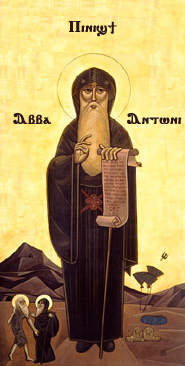This is an old revision of this page, as edited by Jc3schmi (talk | contribs) at 02:36, 4 June 2007 (→See also). The present address (URL) is a permanent link to this revision, which may differ significantly from the current revision.
Revision as of 02:36, 4 June 2007 by Jc3schmi (talk | contribs) (→See also)(diff) ← Previous revision | Latest revision (diff) | Newer revision → (diff)
The Desert Fathers were Christian Hermits, Ascetics and Monks who lived mainly in the Scetes desert of Egypt, beginning in about the third century. Very few of the Desert Fathers lived in other deserted regions of Egypt. The original desert hermits were Christians fleeing the chaos and persecution of the Roman Empire's Crisis of the third century. Christians were often scapegoated during these times of unrest, and near the end of the century, this persecution was made systematic by the emperor Diocletian. In Egypt, Christian refugee communities formed at the edges of population centers, far enough away to be safe from Imperial scrutiny, but still close enough to have access to civilization. Records from this time indicate that Christians often lived in tombs and trashheaps on the edges of major cities, more or less protected by their obscurity.
In 313, when Christianity was made legal in Egypt by Diocletian's successor Constantine I, a trickle of individuals, many of them young men, continued to live in these marginal areas. The solitude of these places attracted them; the privations of the desert were a means of learning stoic self-discipline. These young men saw in Jesus' fasting on the mountain and in his cousin John the Baptist (himself a desert hermit) two models for such self-discipline. These individuals believed that desert life would teach them to eschew the things of this world and allow them to follow God's call in a more deliberate and individual way.
Thus, during the fourth century, the empty areas around Egyptian cities continued to attract Christians from the world over, wishing to live in solitude. As the lifestyle developed, these men and women developed a reputation for holiness and wisdom. In its early form, each hermit followed more or less an individual spiritual program, perhaps learning some basic practices from other monks, but developing them into their own unique (and sometimes highly idiosyncratic) practice. Later monks, notably Anthony the Great, Pachomius and Shenouda the Archimandrite, developed a more regularized approach to desert life, and introduced some aspects of community living (especially common prayer and meals) that would eventually develop into Christian monasticism. Many individuals who spent part of their lives in the Egyptian desert went on to become important figures in the Church and society of the fourth and fifth century, among them Athanasius of Alexandria, John Chrysostom, John Cassian, and Augustine of Hippo. Through the work of these last two, the spirituality of the desert fathers, emphasizing an ascent to God through periods of purgation and illumination that led to unity with the Divine, deeply affected the spirituality of the Western Church. For this reason, the writings and spirituality of the desert fathers are still of interest to many people today.
See also
References
- The Desert Fathers: Translations from the Latin with an Introduction by Helen Waddell, 1936
- Sayings of the Early Christian Monks translated by Benedicta Ward (Cistercian Studies 59), 1987
- The Desert in the Desert: Faith and the Aporias of Law and Knowledge in Derrida and the Sayings of the Desert Fathers by Lori Branch, 2003